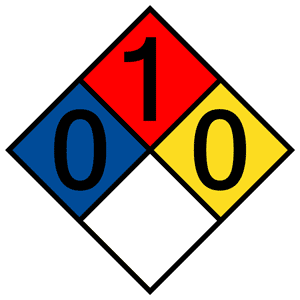
Recent news coming from outside Buffalo, New York about the toxic levels of contaminants found in the air and soil around the Tonawanda Coke plant reminds us to consider our environmental role in the production of green coke. You can read more about the Tonawanda controversy and litigation here and here. While exact disposition of the products from this plant and the process details are not known to us, the news about the toxic materials affecting the surrounding community gives us pause to consider our environmental impacts from the refining side of the coking industry.
Below is the NFPA Diamond associated with Petroleum Coke.
While there are many hazards associated with green coke in the unit, the toxicity and environmental impacts of the petroleum coke itself seems relatively low. A report published by the EPA (link here) in 2007 entitled “Petroleum Coke Category Analysis and Hazard Characterization” demonstrated no or low levels of toxicity in the following categories.
- Fresh water fish and small invertebrates – nontoxic
- Aquatic plants – slight growth inhibition
- Terrestrial plants and earthworms – nontoxic
- Human – extrapolated from monkey and rat studies
- Acute toxicity – acute inhalation issues when particulates are greater than 300 mg/m3
- Repeated exposure – Low level effects were observed presenting as nonspecific particle issues, primarily in lungs and was similar to exposure with most dust particles
- Genetic alterations – none associated with green coke but minor changes were observed by direct interaction with separated VCM molecules
- Carcinogenicity – nothing found over a 2 year daily repeated exposure test
The report indicated that green coke was considered a more severe test case due to the presence of the volatile matter (VCM).
The bottom line seems to be that green coke is fairly non-toxic. However, long-term exposure to the coke dust can cause some respiratory effects. We recommend that care should be taken by sites to minimize exposure to long term coke cutters and those who routinely work in coke barns or loading plants. Modern advances in remote deheading and cutting have allowed for the removal of the coke cutter from the top deck and away from the rail cars, thus reducing much of the daily exposure to petcoke dust and other hazards out there.
If you work in the coker, the material safety datasheet (MSDS) for petcoke (and all other chemicals on your unit) should be readily accessible to you. Have you ever looked at it? Here are a few examples of MSDS sheets for petcoke: Hovensa (link) and Marathon (link).
What is the most toxic thing on the coker? It depends on what type of ancillary equipment might be within your battery limits but rich amine (pH of 13) or caustic (NaOH) could be on the short list. Most of the chemicals on the coker are fairly non-toxic but it is worth considering which ones deserve special care.
Next time you walk by a drum of oil for the rotary joint or the antifoam chemical tote, take a second to consider what is in there and what special safety considerations are associated with that chemical. Also think about where the nearest safety shower, eye wash station is and if that station in good order?
One response to “Petroleum Coke Toxicity”
Leave a Reply
You must be logged in to post a comment.








[…] Coking.com | » Petroleum Coke Toxicity – Recent news coming from outside Buffalo, New York about the toxic levels of contaminants found in the air and soil around the Tonawanda Coke plant reminds us … […]